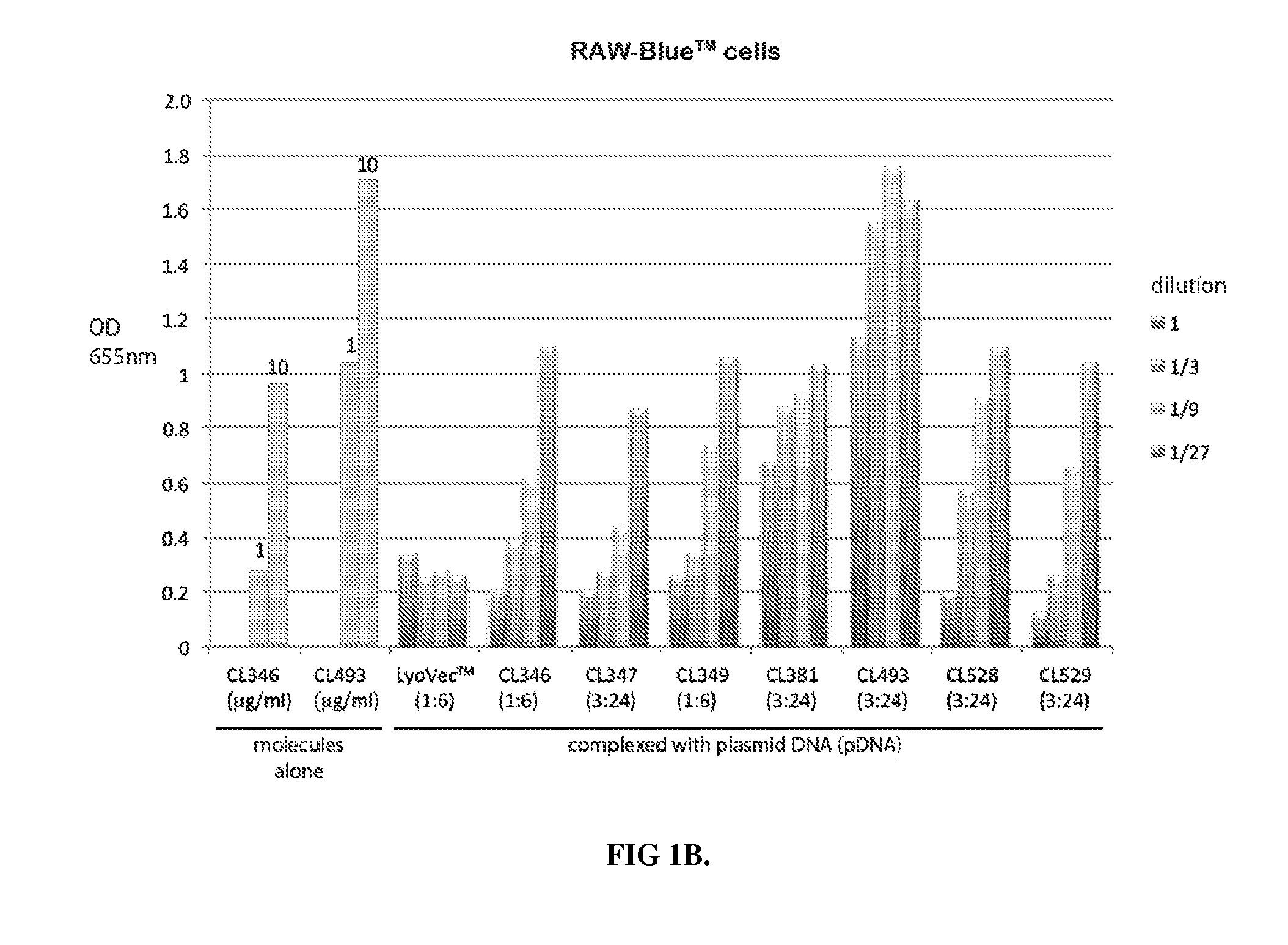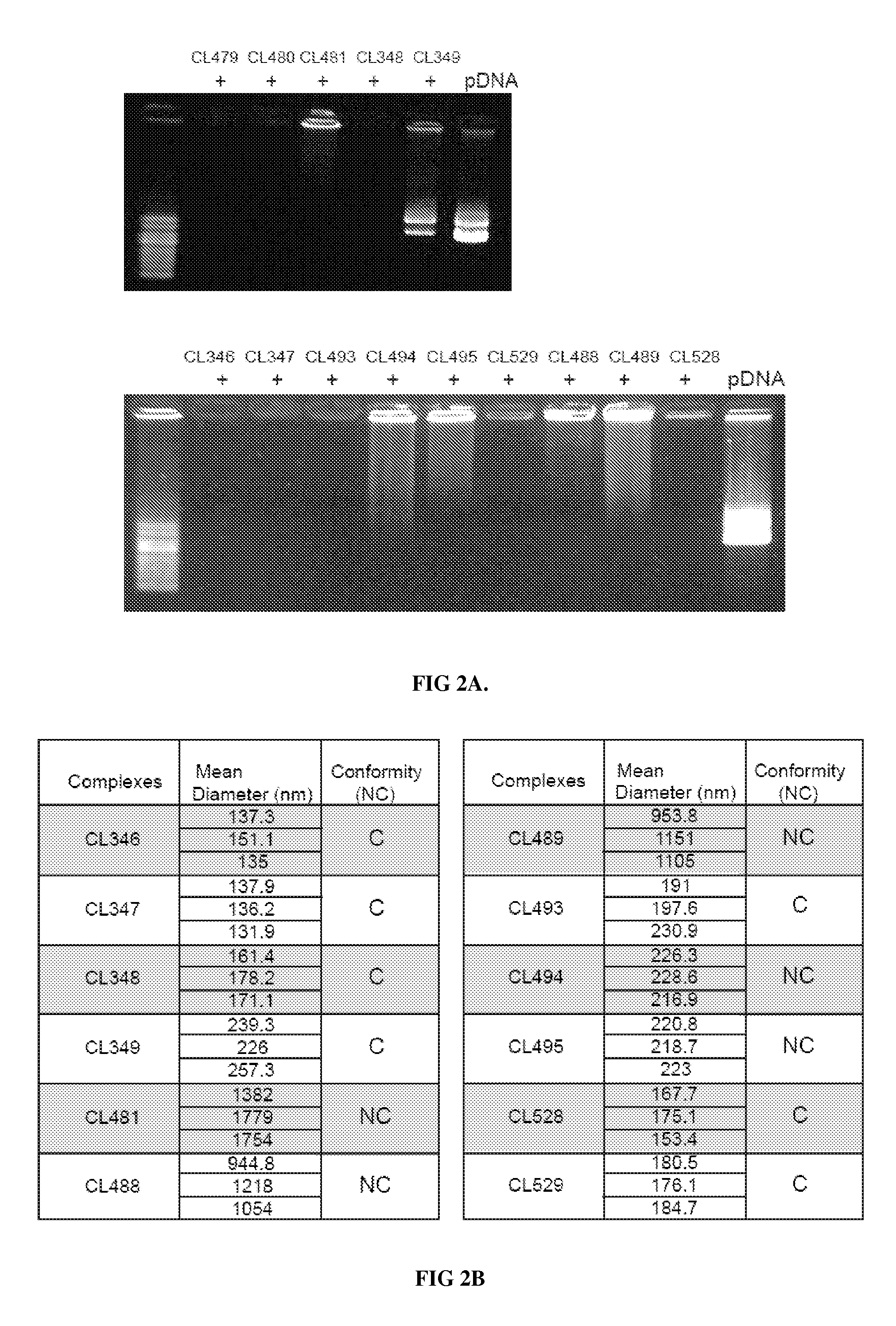Novel compositions of tlr7 and/or tlr8 agonists conjugated to lipids
a technology of lipids and compositions, applied in the field of agonists of tlr7 and/or tlr8, cytosolic nucleic acid sensors, can solve the problems of limited promise of tlr agonist therapeutic potential and the difficulty of systemically targeting and efficiently releasing tlr agonists, and achieve the effect of effectively eliminating tumors and efficiently priming
- Summary
- Abstract
- Description
- Claims
- Application Information
AI Technical Summary
Benefits of technology
Problems solved by technology
Method used
Image
Examples
example 1
Molecule CL346
[0232]
6-amino-2-butylamino-9H-purine
[0233]2-Chloroadenine (10.0 g, 59 mmol), butylamine (43 mL, 589 mmol) and water (40 mL) were placed in an autoclave (250 ml), and the content of the autoclave was allowed to react at 18° C. for 18 hours. The reaction solution was concentrated under reduced pressure, and water was poured into the residue to precipitate a solid. The precipitated solid was sequentially washed with water, EtOH and acetone. Thus, 10.39 g of the title compound was obtained as a yellowish orange powdery solid (yield: 86%). Intermediate 1 was characterized by the following spectroscopic data: 1H NMR (DMSO-d6, 300 MHz): 11.92 (br. S, 1H), 7.63 (s, 1H), 6.51 (br. s, 2H), 6.04 (s, 1H), 3.19 (q, 2H), 1.51 (m, 2H), 1.33 (m, 2H), 0.92 (t, 3H).
Methyl 4-((6-amino-2-(butylamino)-9H-purin-9-yl)methyl)benzoate
[0234]6-amino-2-butylamino-9H-purine (10.39 g, 50.4 mmol) and Cs2CO3 (16.42 g, 50.4 mmol) were suspended in DMF (200 ml). 4-bromomethyl benzoate (13.85 mg, 60.4 m...
example 2
Molecule CL347
[0245]
Benzyl 2-(4-((6-amino-2-(butylamino)-8-hydroxy-9H-purin-9-yl)methyl)benzamido)acetate
[0246]To a suspension of intermediate 4 (4 g, 11 mmol) in dry DMF (20 mL) was added Glycine benzyl ester hydrochloride (2.7 g, 13 mmol), followed by PyBOP (6.4 g, 12 mmol) and N-methylmorpholine (5.68 g, 56.1 mmol). The mixture was stirred at RT for 18H00. The solvent was then removed in vacuo and the residue was dissolved in EtOAc (50 mL) and was washed with water, saturated solution of NH4Cl and brine. The organic layer was dried over MgSO4, filtered and concentrated in vacuo. The crude material was purified on column of silica gel (5% MeOH / DCM) to give the subject compound (5.65 g, yield 100%). Intermediate 13 was characterized by the following spectroscopic data: 1H NMR (DMSO-d6, 300 MHz) δ (ppm) 9.68 (sl, 1H), 8.89 (m, 1H), 7.81 (d, 2H), 7.37 (m, 7H), 6.25 (t, 1H), 6.04 (sl, 2H), 5.15 (s, 2H), 4.86 (s, 2H), 4.06 (d, 2H), 3.15 (m, 2H), 1.49 (m, 2H), 1.33 (m, 2H), 0.86 (t, 3H)...
example 3
Molecule CL348
[0249]
di(Z)-octadec-9-enyl 3-bromopropylphosphonate
[0250]The 3-bromopropyl dichlorophosphine (3.0 g, 12.5 mmol) was dissolved in dry toluene (30 mL) under argon and ice cooling. DIEA (5.46 mL, 31.3 mmol) was added, followed by oleyl alcohol (9.29 mL, 25.01 mmol). The mixture was stirred at RT for 18 hr. Then, the mixture was filtered under minimal exposure to air, the filter washed with dry Diethyl ether, and the filtrate concentrated in vacuo. The residue was chromatographed on silica gel in a gradient of EtOAc in Cyclohexane rising from 20% to 80%. Fractions containing product were combined, and concentrated in vacuo, to obtain the title compound as an oil (2.68 g, 54%). Intermediate 16 was characterized by the following spectroscopic data: 1H NMR (CDCl3-d1, 300 MHz) δ (ppm) 5.36 (m, 4H), 4.03 (m, 4H), 3.62 (m, 2H), 2.19-1.88 (m, 12H), 1.70-1.63 (m, 8H), 1.31 (m, 44H), 0.86 (t, 6H).
N1-N5-N10-triBoc-N14-(di(Z)-octadec-9-enyl propylphosphonate)spermine
[0251]To a soluti...
PUM
| Property | Measurement | Unit |
|---|---|---|
| pH | aaaaa | aaaaa |
| pharmaceutical composition | aaaaa | aaaaa |
| molecular structures | aaaaa | aaaaa |
Abstract
Description
Claims
Application Information
 Login to View More
Login to View More - R&D
- Intellectual Property
- Life Sciences
- Materials
- Tech Scout
- Unparalleled Data Quality
- Higher Quality Content
- 60% Fewer Hallucinations
Browse by: Latest US Patents, China's latest patents, Technical Efficacy Thesaurus, Application Domain, Technology Topic, Popular Technical Reports.
© 2025 PatSnap. All rights reserved.Legal|Privacy policy|Modern Slavery Act Transparency Statement|Sitemap|About US| Contact US: help@patsnap.com



